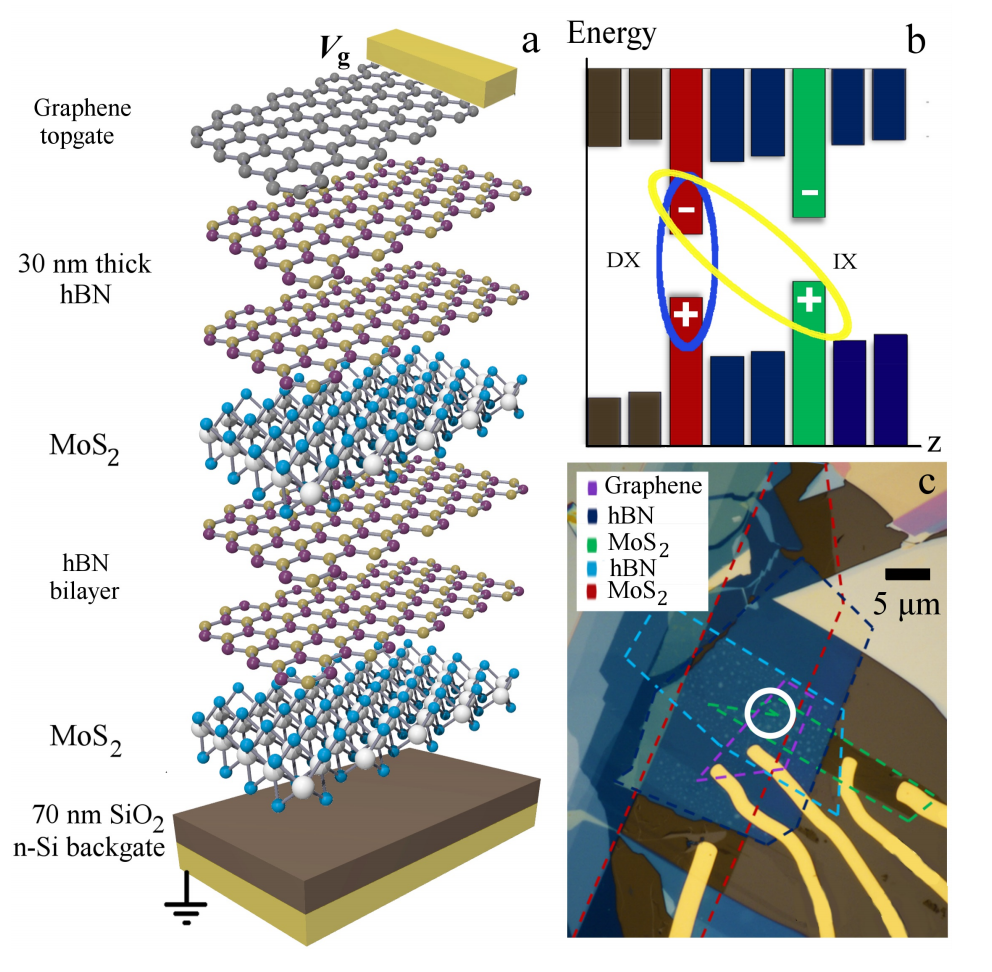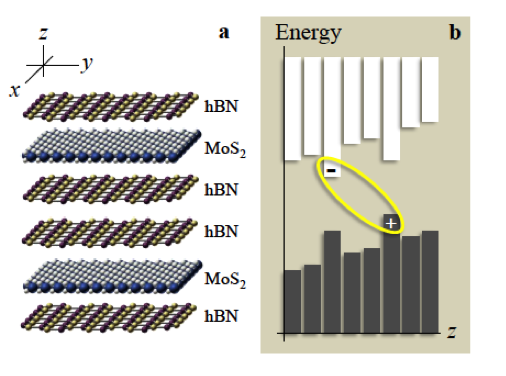Interference dislocations adjacent to emission spot |
|
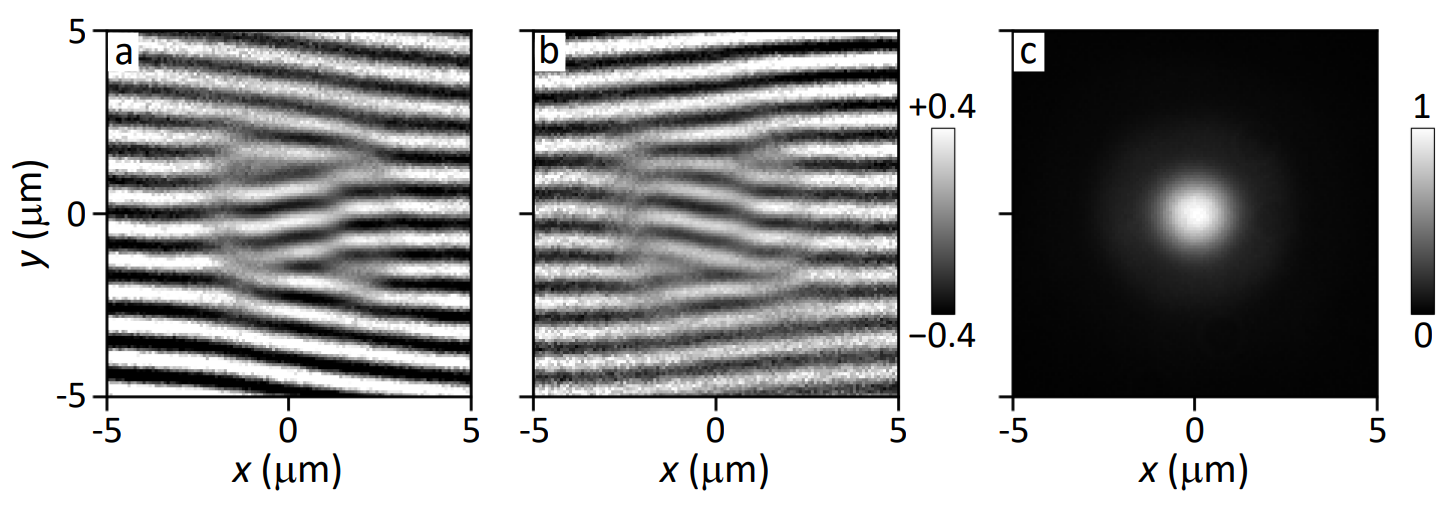
|
We studied interference dislocations (forks) adjacent to an emission spot in an interference pattern. The adjacent interference dislocations are observed in emission of excitons in a monolayer transition metal dichalcogenide and in emission of spatially indirect excitons, also known as interlayer excitons, in a van der Waals heterostructure. The simulations show that the adjacent interference dislocations appear due to the moiré effect in combined interference patterns produced by constituting parts of the emission spot. The adjacent interference dislocations can appear in interference images for various spatially modulated emission patterns.
J. R. Leonard, L. H. Fowler-Gerace, Zhiwen Zhou, E. A. Szwed, D. J. Choksy, L. V. Butov, Interference dislocations adjacent to emission spot, arXiv:2511.01155 (2025). |
Long-range spatial extension of exciton states in van der Waals heterostructure |
|

|
Narrow lines in photoluminescence (PL) spectra of excitons are characteristic of low-dimensional semiconductors. These lines correspond to the emission of exciton states in local minima of a potential energy landscape formed by fluctuations of the local exciton environment in the heterostructure. The spatial extension of such states was in the nanometer range. In this work, we present studies of narrow lines in PL spectra of spatially indirect excitons (IXs) in a MoSe2/WSe2 van der Waals heterostructure. The narrow lines vanish with increasing IX density. The disappearance of narrow lines correlates with the onset of IX transport, indicating that the narrow lines correspond to localized exciton states. The narrow lines extend over distances reaching several micrometers and over areas reaching ca. ten percent of the sample area. This macroscopic spatial extension of the exciton states, corresponding to the narrow lines, indicates a deviation of the exciton energy landscape from random potential and shows that the excitons are confined in moiré potential with a weak disorder.
Zhiwen Zhou, E. A. Szwed, W. J. Brunner, H. Henstridge, L. H. Fowler-Gerace, L. V. Butov, Long-range spatial extension of exciton states in van der Waals heterostructure, arXiv:2508.20306 (2025). |
Efficient transport of indirect excitons in a van der Waals heterostructure |
|

|
Exciton transport is fundamental for understanding transport phenomena in bosonic systems and for embracing excitation energy transfer in materials. Spatially indirect excitons (IXs) are composed of electrons and holes in separated layers. Long IX lifetimes allow them to form quantum bosonic states and travel long distances. In this work, we measured IX transport in a MoSe2/WSe2 van der Waals heterostructure by time-resolved photoluminescence imaging. These measurements probe the kinetics of IX cloud expansion and reveal the transport characteristics. We found IX transport with anomalously high diffusivity, orders of magnitude higher than for regular diffusive exciton transport in van der Waals heterostructures. This efficient IX transport agrees with long-range ballistic transport and is consistent with the Bose-Hubbard theory prediction of superfluid in moire superlattices.
Zhiwen Zhou, W. J. Brunner, E. A. Szwed, H. Henstridge, L. H. Fowler-Gerace, L. V. Butov, Efficient transport of indirect excitons in a van der Waals heterostructure, arXiv:2507.04556 (2025). |
Long-distance decay-less spin transport in indirect excitons in a van der Waals heterostructure |
|
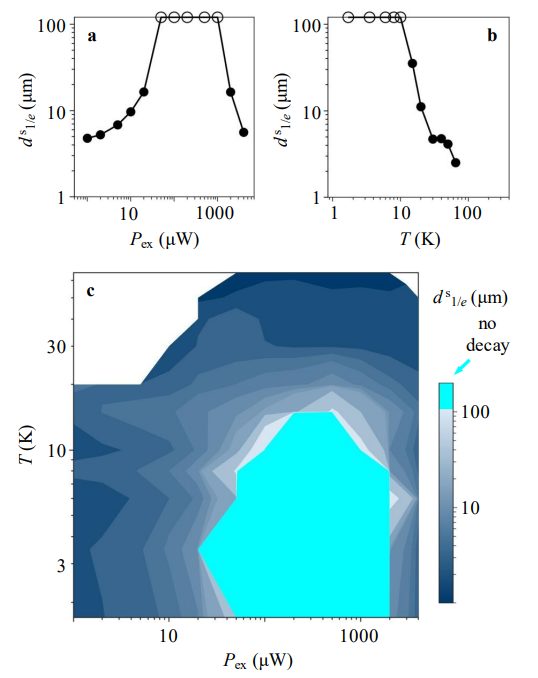
|
In addition to its fundamental interest, the long-distance spin transport with suppressed spin losses is essential for spintronic devices. However, the spin relaxation caused by scattering of the particles carrying the spin, limits the spin transport. We explored spatially indirect excitons (IXs), also known as interlayer excitons, in van der Waals heterostructures (HS) composed of atomically thin layers of transition-metal dichalcogenides (TMD) as spin carries. TMD HS also offer coupling of spin and valley transport. We observed the long-distance spin transport with the decay distances exceeding 100~μm and diverging so spin currents show no decay in the HS. With increasing IX density, we observed spin localization, then long-distance spin transport, and then reentrant spin localization, in agreement with the Bose-Hubbard theory prediction for superfluid and insulating phases in periodic potentials due to moiré superlattices. The suppression of scattering in exciton superfluid suppresses the spin relaxation and enables the long-distance spin transport. This mechanism of protection against the spin relaxation makes IXs a platform for the realization of long-distance decay-less spin transport.
Zhiwen Zhou, E. A. Szwed, D. J. Choksy, L. H. Fowler-Gerace, L. V. Butov, Long-distance decay-less spin transport in indirect excitons in a van der Waals heterostructure, arXiv:2406.04440 (2024). Nat. Commun. 15, 9454 (2024). |
Transport and localization of indirect excitons in a van der Waals heterostructure |
|
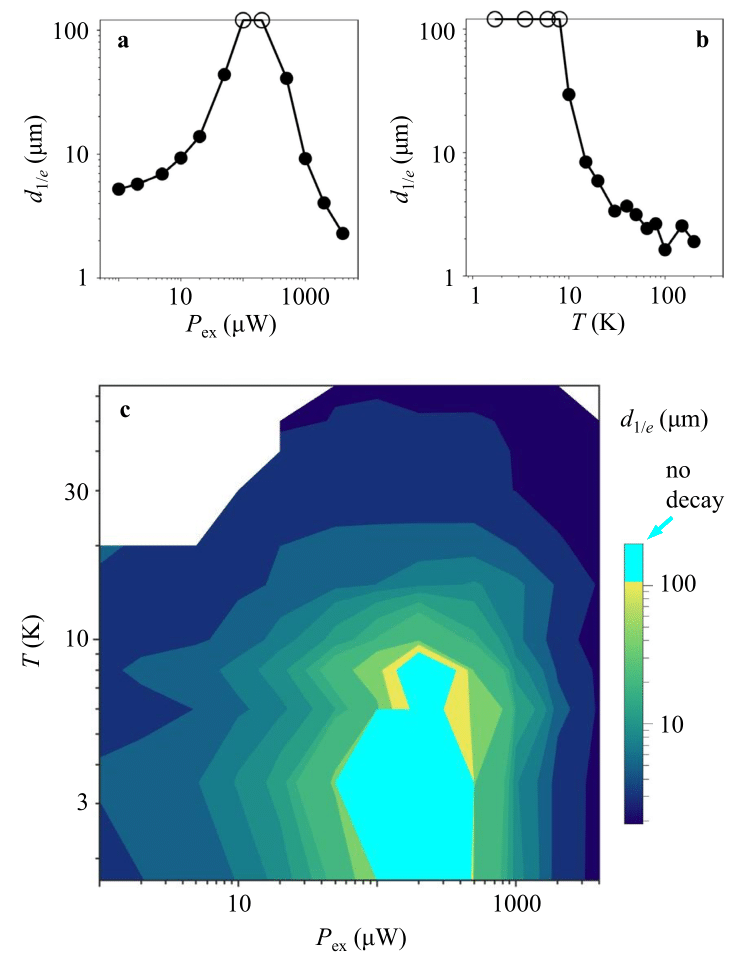
|
Long lifetimes of spatially indirect excitons (IXs), also known as interlayer excitons, allow implementing both quantum exciton systems and long-range exciton transport.
Van der Waals heterostructures (HS) composed of atomically thin layers of transition-metal dichalcogenides (TMD) offer the opportunity to explore IXs in moiré superlattices.
The moiré IXs in TMD HS form the materials platform for exploring the Bose-Hubbard physics and superfluid and insulating phases in periodic potentials. IX transport in TMD
HS was intensively studied and diffusive IX transport with 1/e decay distances d1/e up to ∼3 μm was realized. In this work, we present in MoSe2/WSe2 HS the IX long-range
transport with d1/e exceeding 100 μm and diverging at the optical excitation resonant to spatially direct excitons. The IX long-range transport vanishes at high temperatures.
With increasing IX density, IX localization, then IX long-range transport, and then IX reentrant localization is observed. The results are in qualitative agreement with the
Bose-Hubbard theory of bosons in periodic potentials predicting superfluid at N∼1/2 and insulating at N∼0 and N∼1 phases for the number of bosons per site of the periodic
potential N.
L. H. Fowler-Gerace*, Zhiwen Zhou*, E. A. Szwed, D. J. Choksy, L. V. Butov, Transport and localization of indirect excitons in a van der Waals heterostructure, arXiv:2307.00702 (2023). Nat. Photon. 18, 823 (2024). |
Voltage-controlled long-range propagation of indirect excitons in van der Waals heterostructure |
|
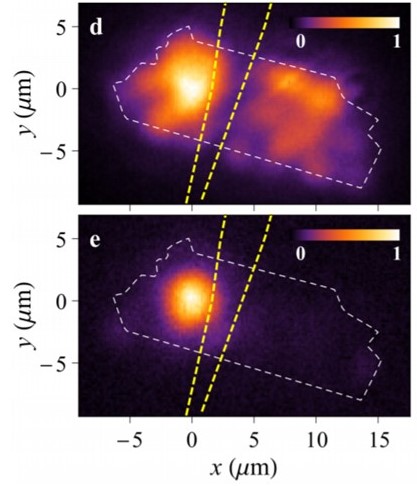
|
Indirect excitons (IXs), also known as interlayer excitons, can form the medium for excitonic devices whose operation is based on controlled propagation of excitons. A proof of principle for excitonic devices was demonstrated in GaAs heterostructures where the operation of excitonic devices is limited to low temperatures. IXs in van der Waals transition-metal dichalcogenide (TMD) heterostructures are characterized by high binding energies making IXs robust at room temperature and offering an opportunity to create excitonic devices operating at high temperatures suitable for applications. However, a characteristic feature of TMD heterostructures is the presence of moiré superlattice potentials, which are predicted to cause modulations of IX energy reaching tens of meV. These in-plane energy landscapes can lead to IX localization, making IX propagation fundamentally different in TMD and GaAs heterostructures and making uncertain whether long-range IX propagation, sufficiently long to allow for creating elaborate excitonic devices and circuits, can be realized in TMD heterostructures. In this work, we realize long-range IX propagation with the 1/e IX luminescence decay distances reaching 13 microns in a MoSe2/WSe2 heterostructure. We trace the IX luminescence along the IX propagation path. In the presented TMD materials, the long-range IX propagation occurs up to ∼50K. This is a step toward the room temperature operation, which can be realized in TMD heterostructures due to the high IX binding energy. We also realize control of the long-range IX propagation by voltage. The IX luminescence signal in the drain of an excitonic transistor is controlled within 40 times by gate voltage. The control of the IX propagation in the MoSe2/WSe2 heterostructure is governed by new mechanisms, beyond the mechanism for controlling IX transport by an energy barrier to IX propagation (or a trap for IXs) created by the gate electrode, known since the studies of GaAs heterostructures. We discuss the origin of the voltage-controlled long-range IX propagation in the MoSe2/WSe2 heterostructure, in particular, the electric-field control of the moiré potential.
L. H. Fowler-Gerace, D. J. Choksy, and L. V. Butov, Voltage-controlled long-range propagation of indirect excitons in van der Waals heterostructure, arXiv:2101.01262 (2021), Phys. Rev. B 104, 165302 (2021). |
Indirect excitons and trions in MoSe2/WSe2 van der Waals heterostructures |
|
|
|
Indirect excitons (IX) in semiconductor heterostructures are bosons, which can cool below the temperature of quantum degeneracy and can be effectively controlled by voltage and light. IX quantum Bose gases and IX devices were explored in GaAs heterostructures where an IX range of existence is limited to low temperatures due to low IX binding energies. IXs in van der Waals transition-metal dichalcogenide (TMD) heterostructures are characterized by large binding energies giving the opportunity for exploring excitonic quantum gases and for creating excitonic devices at high temperatures. TMD heterostructures also offer a new platform for studying single-exciton phenomena and few-particle complexes. In this work, we present studies of IXs in MoSe2/WSe2 heterostructures and report on two IX luminescence lines whose energy splitting and temperature dependence identify them as neutral and charged IXs. The experimentally found binding energy of the indirect charged excitons, that is, indirect trions, is close to the calculated binding energy of 28 meV for negative indirect trions in TMD heterostructures [Deilmann, T.; Thygesen, K. S. Nano Lett. 2018, 18, 1460]. We also report on the realization of IXs with a luminescence line width reaching 4 meV at low temperatures. An enhancement of IX luminescence intensity and the narrow line width are observed in localized spots.
E. V. Calman, L. H. Fowler-Gerace, D. J. Choksy, L. V. Butov, D. E.Nikonov, I. A. Young, S. Hu, A. Mishchenko, and A. K. Geim. Indirect excitons and trions in MoSe2/WSe2 van der Waals heterostructures, arXiv:1901.08664 (2019), Nano Lett. 20, 1869 (2020). |
Indirect excitons in van der Waals heterostructures at room temperature |
|
Indirect excitons (IXs) in van der Waals transition-metal dichalcogenide (TMD) heterostructures are characterized by a high binding energy making them stable at room temperature and giving the opportunity for exploring fundamental phenomena in excitonic systems and developing excitonic devices operational at high temperatures. We present the observation of IXs at room temperature in van der Waals TMD heterostructures based on monolayers of MoS2 separated by atomically thin hexagonal boron nitride. The IXs realized in the TMD heterostructure have lifetimes orders of magnitude longer than lifetimes of direct excitons in single-layer TMD, and their energy is gate controlled.
E.V. Calman, M.M. Fogler, L.V. Butov, S. Hu, A. Mishchenko, A.K. Geim. Indirect excitons in van der Waals heterostructures at room temperature, arXiv:1709.07043 (2017), Nature Commun. 9, 1895 (2018). |
|
Control of excitons in multi-layer van der Waals heterostructures |
|
We report an experimental study of excitons in a double quantum well van der Waals heterostructure made of atomically thin layers of MoS2 and hexagonal boron nitride (hBN). The emission of neutral and charged excitons is controlled by gate voltage, temperature, and both the helicity and the power of optical excitation.
E. V. Calman, C. J. Dorow, M. M. Fogler, L. V. Butov, S. Hu, A. Mishchenko, A. K. Geim, Control of excitons in multi-layer van der Waals heterostructures, arXiv:1510.04410 (2015), Appl. Phys. Lett. 108, 101901 (2016). |
|
Indirect excitons in van der Waals heterostructures |
|
All known superfluid and superconducting states of condensed matter are enabled by composite bosons (atoms, molecules, Cooper pairs) made of an even number of fermions. Temperatures where such macroscopic quantum phenomena occur are limited by the lesser of the binding energy and the degeneracy temperature of the bosons. High critical temperature cuprate superconductors set the present record of ~100 K. Here we propose a design for artificially structured materials to rival this record. The main elements of the structure are two monolayers of a transition metal dichalcogenide separated by an atomically thin spacer. Electrons and holes generated in the system would accumulate in the opposite monolayers and form bosonic bound states --- the indirect excitons. The resultant degenerate Bose gas of indirect excitons would exhibit macroscopic occupation of a quantum state and vanishing viscosity at high temperatures.
M.M. Fogler, L.V. Butov, K.S. Novoselov, High-temperature superfluidity with indirect excitons in van der Waals heterostructures, arXiv:1404.1418 (2014), Nature Commun. 5, 4555 (2014). |
|



